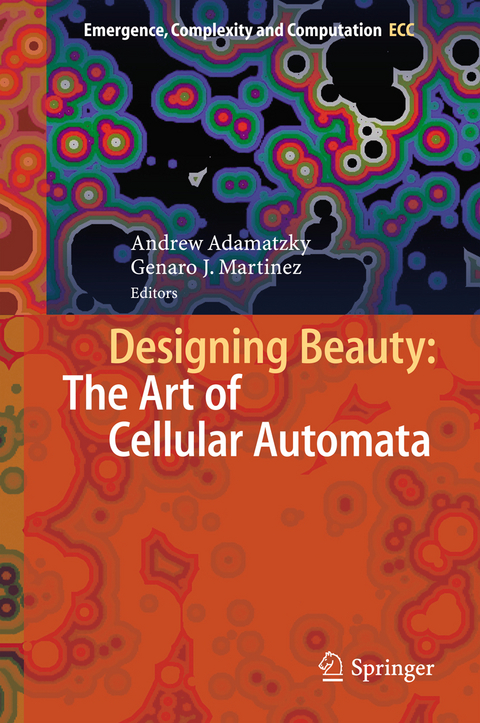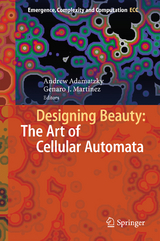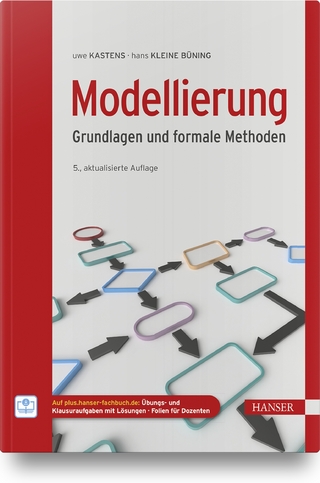Designing Beauty: The Art of Cellular Automata
Springer International Publishing (Verlag)
978-3-319-27269-6 (ISBN)
This fascinating, colourful book offers in-depth insights and first-hand working experiences in the production of art works, using simple computational models with rich morphological behaviour, at the edge of mathematics, computer science, physics and biology. It organically combines ground breaking scientific discoveries in the theory of computation and complex systems with artistic representations of the research results. In this appealing book mathematicians, computer scientists, physicists, and engineers brought together marvelous and esoteric patterns generated by cellular automata, which are arrays of simple machines with complex behavior. Configurations produced by cellular automata uncover mechanics of dynamic patterns formation, their propagation and interaction in natural systems: heart pacemaker, bacterial membrane proteins, chemical rectors, water permeation in soil, compressed gas, cell division, population dynamics, reaction-diffusion media and self-organisation.
The book inspires artists to take on cellular automata as a tool of creativity and it persuades scientists to convert their research results into the works of art.
The book is lavishly illustrated with visually attractive examples, presented in a lively and easily accessible manner.
Andrew Adamatzky is a professor at the Department of Computer Science and Director of the Unconventional Computing Centre, University of the West of England, Bristol, UK. He does research in reaction-diffusion computing, cellular automata, massive parallel computation, collective intelligence, bionics, complexity, non-linear science, novel hardware. Genaro J Martinez is a professor at the School of Computer Sciences, National Polytechnic Institute, Mexico City, Mexico and visiting fellow at the Unconventional Computing Centre, University of the West of England, Bristol, UK. His does research in cellular automata, unconventional computing, artificial life, complex systems, and swarm robotics.
Self-Organizing Two-Dimensional Cellular Automata: 10 Still Frames.- Is it Art or Science?.- Larger than Life.- Three Favorite Cellular Automata.- Cellular Automata: Dying to Live Again, Architecture, Art, Design.- In Search of Movement and Life on a Static Grid.- Some Beautiful and Difficult Questions about Cellular Automata.- Hyperbolic Gallery.- Evolved Gliders and Waves on a Geodesic Grid.- Constructing Counters through Evolution.- Biological Lattice-Gas Cellular Automata.- The Enlightened Game of Life.- Small Synchronizers and Prime Generators.- Ecological Patterns of Self-Replicators.- The Art of Penrose Life.- Asynchronous Cellular Automata Simulating Complex Phenomena.- A Multiparticle Lattice-Gas Cellular Automaton Simulating a Piston Motion.- Two Layer Asynchronous Cellular Automata.- Cellular Automata Simulation of Bacterial Cell Growth and Division.- Seismic Cellular Automata.- DNA Cellular Automata.- Reversibility, Simulation and Dynamical Behaviour.- Aesthetics and Randomness in Cellular Automata.- Cellular Automata with Memory.- Turing Machine in Conway Game of Life.- Aperiodicity and Reversibility.- Cardiac Pacemaker Tissue by Cellular Automata. Patterns in Cellular Automata.- Gliders in One-Dimensional Cellular Automata.- Excitable Automata.
"The authors succinctly describe the core ideas of the automata used to generate the beautiful images, and some of the interesting explorations that led to the particular calculations behind the images included in the book. ... The images and the reference list together make the book a valuable starting point for those interested in the theory or the art, or those who simply want to find websites where these fascinating ideas can be explored and images created." (D. T. Barnard, Computing Reviews, April, 2016)
"Cellular automata (CA) are discrete time dynamical systems that consist of a regular grid of cells. ... It is primarily a collection of nice pictures that were generated by CA. ... the book should inspire the scientist to present his or her work in a pleasing and graphically attractive way, and it should invite artists to explore the possibilities to be creative with CA. ... this is a survey that can get you started to explore a catchy subject." (Megan Patnott, MAA Reviews, maa.org, August, 2016)
| Erscheinungsdatum | 19.02.2016 |
|---|---|
| Reihe/Serie | Emergence, Complexity and Computation |
| Zusatzinfo | IX, 191 p. 128 illus., 60 illus. in color. |
| Verlagsort | Cham |
| Sprache | englisch |
| Maße | 155 x 235 mm |
| Themenwelt | Mathematik / Informatik ► Informatik ► Theorie / Studium |
| Mathematik / Informatik ► Mathematik ► Angewandte Mathematik | |
| Technik | |
| Schlagworte | artificial intelligence (incl. robotics) • Arts • Cellular Automata • collective behavior • Complexity • Computer Art • Engineering • Mathematical and Computational Biology • Mathematical Machines • Nonlinear Dynamics • Popular Science, general • Self-Organization • Theory of Computation |
| ISBN-10 | 3-319-27269-1 / 3319272691 |
| ISBN-13 | 978-3-319-27269-6 / 9783319272696 |
| Zustand | Neuware |
| Haben Sie eine Frage zum Produkt? |
aus dem Bereich




